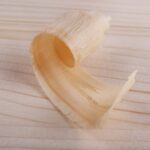What is a brad in woodworking? For those new to the craft, understanding the different types of fasteners and their uses is essential. In this article, we will explore the definition of a brad in woodworking, the various types available, their purpose and function in woodworking projects, how to use them effectively, common mistakes to avoid, and how they compare to other woodworking fasteners.
In woodworking, brads are small, thin nails with a slender profile that are designed for securing lightweight trim and moldings without splitting the wood. They are typically made of steel or brass and come in various lengths and thicknesses to accommodate different woodworking applications.
Brads are commonly used for attaching decorative trims, paneling, and other delicate wood pieces where a more substantial nail or screw might cause damage. Their small size allows for a discreet finish while providing enough holding power for lighter materials. Understanding how to use brads effectively can greatly enhance the quality and appearance of your woodworking projects.
Definition of a Brad in Woodworking
What Is a Brad in Woodworking?
In the world of woodworking, a brad refers to a type of nail specifically designed for use in woodworking projects. Brads are thin and small in size, making them perfect for delicate and intricate woodwork. They are also known for their clean finish, as they leave behind minimal visible impact on the wood once driven in.
Characteristics of Brads
Brads are characterized by their fine shank and small head, which allows them to be easily concealed within the wood. They are available in various lengths and gauges, providing woodworkers with options to suit different types of woodworking tasks. Additionally, brads are made from different materials such as steel, stainless steel, or brass, adding to their versatility and suitability for different woodworking applications.
Uses of Brads
Brads are commonly used in woodworking for tasks such as attaching lightweight trim, securing delicate moldings, setting up decorative pieces, or fastening thin wooden panels. Their small size and clean finish make them ideal for applications where larger nails or screws may be too obtrusive or damaging to the wood. With their subtle appearance and precision, brads are often preferred for projects that require a seamless and polished look.
Types of Brads Used in Woodworking
Brads come in a variety of types, each designed for different purposes and applications in woodworking projects. Here are some of the most common types of brads used in woodworking:
- Traditional Brads: These are thin, small nails with a small head that can be easily concealed. They are commonly used for attaching lightweight trim, moldings, and other delicate woodworking pieces.
- Headless Brads: As the name suggests, these brads have no heads, making them virtually invisible once they are driven into the wood. They are often used in finishing work where concealing the fastener is important.
- Stainless Steel Brads: These brads are rust-resistant, making them ideal for outdoor or high-moisture applications. They provide strong holding power and durability in various woodworking projects.
- Gauge Brads: This type of brad comes in different thicknesses or gauges to accommodate different weight and strength requirements. Thicker gauge brads provide more holding power and are suitable for heavier woodworking projects.
Each type of brad has its own unique features and benefits, making it important to select the right type based on the specific needs of your woodworking project. Whether you need a nearly invisible fastener or a durable option for outdoor use, there is likely a type of brad that will suit your needs.
Understanding the characteristics and uses of each type of brad will allow you to choose the appropriate one for your woodworking project and ensure that it provides the strength and support required while maintaining a professional finish.
In addition to considering the type of material from which the brad is made, it is essential to factor in the length and gauge of the brad when selecting the appropriate type for your specific project. By choosing the right type of brad based on these considerations, you can ensure a successful outcome for your woodworking endeavors.
The Purpose and Function of Brads in Woodworking Projects
In woodworking, a brad is a type of fastener that is commonly used to attach lightweight materials such as trim and molding. A brad is essentially a thin, small-gauge nail with a small head that can be easily concealed. The primary purpose of using brads in woodworking projects is to create a secure and neat finish without the need for large, unsightly nail heads.
When it comes to the function of brads in woodworking, they are primarily used for attaching delicate or thin pieces of wood together. Due to their small size and thin gauge, they are less likely to split the wood when driven in, making them ideal for delicate projects. Brads are often used with a brad nailer, which is a specialized pneumatic tool designed specifically for driving brads into wood with precision and ease.
In addition to attaching delicate materials, brads are also commonly used for decorative trim work and interior finishing. They provide a clean and polished look when installed properly, making them an essential component in achieving professional-looking results in woodworking projects. Overall, the purpose and function of brads in woodworking projects revolve around creating a secure yet aesthetically pleasing finish.
| Brads | Woodworking Projects |
|---|---|
| Used to attach lightweight materials | Create secure and neat finish without large nail heads |
| Ideal for delicate projects due to small size | Provide clean and polished look for decorative trim work |
How to Use Brads in Woodworking
Brads are small, thin nails with a slight head that is almost invisible once it’s been driven into wood. They’re used for light – to medium-duty fastening jobs in woodworking and can be easily concealed, leaving a minimal impact on the project’s appearance. Below are some steps on how to use brads effectively in your woodworking projects:
1. Preparing the Surface: Before you start using brads, make sure the wood surface is clean and free of any debris that may interfere with the brad’s penetration.
2. Choosing the Right Brads: There are different types of brads available based on length and gauge. Make sure to choose the appropriate type for your project.
3. Using a Brad Nailer: A brad nailer is the best tool for driving brads into wood quickly and efficiently. Load the brads into the nailer, adjust its pressure according to the density of wood, and aim it at a 45-degree angle before pulling the trigger.
4. Manual Application: If you don’t have a brad nailer, you can also use a hammer to drive in the brad manually by holding it against the surface and tapping gently with a hammer until it’s flush.
Remember, no matter how you apply them, always ensure that there is at least ¾ of an inch space between where you place each brad to prevent splitting or damaging the wood surface.
5. Finishing Touches: After inserting all necessary brads into your project, ensure they’re flush with the surface while not causing any damage or breakage around it by gently tapping them in place if needed.
Using these steps properly will allow for a professional looking finishing touch on many projects without having distracting markings left from screw holes or larger finishing nails.
Tips and Tricks for Using Brads Effectively
When it comes to using brads effectively in woodworking projects, there are a few tips and tricks that can make the process easier and ensure a professional result. One key tip is to always use the right size of brad for your project.
Using a brad that is too long or too short can result in ineffective fastening and potential damage to your woodwork. It’s important to carefully select the appropriate size based on the thickness of the wood you are working with.
Another tip for using brads effectively is to properly prepare the surface before driving in the brad. This means ensuring that the wood is clean, free of any debris, and appropriately pre-drilled if necessary. This preparation will help prevent any splitting or cracking of the wood when inserting the brad.
Additionally, it’s important to choose the right tool for driving in your brads. A nail gun or pneumatic brad nailer can be a convenient option for larger projects, while a hammer and manual nail set may be more suitable for smaller, delicate work. Choosing the right tool for your specific project will help ensure accuracy and precision when driving in your brads.
Overall, using brads effectively in woodworking involves careful planning, attention to detail, and a focus on precision. By following these tips and tricks, you can achieve professional results with your woodworking projects while utilizing this versatile fastener.
Lastly, it’s important to practice patience when working with brads. Rushing through the process can lead to errors and damages to your materials. Taking your time and being deliberate with each step will ultimately lead to better results in your woodworking projects.
Common Mistakes to Avoid When Using Brads in Woodworking
When utilizing brads in woodworking projects, it is important to be aware of common mistakes that can occur. One common mistake to avoid is using the wrong size of brad for the task at hand. It is crucial to choose the appropriate length and gauge of brad for your specific woodworking project. Using a brad that is too long or too short can result in the wood splitting or the brad not holding securely.
Another mistake to avoid is not properly preparing the surface before inserting the brad. Failing to pre-drill pilot holes or not countersinking the brad can lead to surface damage and a less professional finish. Additionally, it is essential to make sure that the wood pieces are securely fastened together before using the brads, as this can prevent misalignment and uneven placement of the brads.
Furthermore, one should also avoid over-relying on brads as the sole fastening method in certain woodworking projects. While brads are useful for temporary or light-duty applications, for heavier loads or structural support, it is best to use other types of fasteners such as screws or nails in conjunction with brads.
Overall, understanding these common mistakes and taking precautions will result in a more successful and professional woodworking project when using brads.
| Common Mistakes | How to Avoid Them |
|---|---|
| Using wrong size of brad | Choose appropriate length and gauge based on project needs |
| Improperly preparing surface | Pre-drill pilot holes and countersink before inserting brads |
| Over-relying on brads as sole fastening method | Use other types of fasteners when needed for heavier loads or structural support |
Comparison of Brads With Other Woodworking Fasteners
When it comes to woodworking, using the right fasteners is crucial for ensuring the strength and durability of your projects. In this section, we will compare brads with other popular woodworking fasteners to help you understand their pros and cons.
Brads vs Nails
One of the most common comparisons in woodworking is brads versus nails. While both are used for fastening wood, there are some key differences between the two. Brads are thinner and smaller than nails, making them less likely to split delicate or thin wood pieces. They also leave smaller holes, which means less visible damage to the wood surface. Nails, on the other hand, provide greater holding power and are better suited for heavy-duty projects.
Brads vs Staples
Staples are another popular choice for securing wood pieces together in woodworking projects. The main difference between brads and staples lies in their design and application. Brads have a smooth, straight design which makes them ideal for finishing tasks where appearance is important. On the other hand, staples have a crown-like shape that provides more holding power but may not be suitable for fine or delicate surfaces.
Brads vs Screws
Screws are often considered a more versatile option compared to brads due to their superior holding power and ability to create stronger joints. However, screws require pre-drilling and may not be suitable for certain finishing tasks where a clean appearance is necessary. Brads, on the other hand, can be easily hidden within the wood surface without compromising its overall aesthetics.
Conclusion and Final Thoughts on the Importance of Brads in Woodworking
In conclusion, brads are an essential component in woodworking, serving as fasteners that provide a secure and subtle way to join pieces of wood together. Whether you are working on furniture, cabinets, or decorative woodwork, knowing how to use brads effectively can make a significant difference in the outcome of your project. Understanding the different types of brads available and their various uses can help you choose the right one for your specific woodworking needs.
Brads play a crucial role in woodworking projects by providing a neat and clean finish with minimal visibility. They are especially useful for delicate and intricate work where larger fasteners might be too obtrusive. Knowing how to use brads properly, including tips and tricks for effective application, can greatly enhance the quality of your woodworking projects.
Although there are other alternatives to brads in woodworking, such as nails and screws, brads offer unique advantages in terms of appearance and ease of use. Their small size and precise application make them ideal for delicate or detailed work where aesthetics are important. Overall, understanding what is a brad in woodworking is essential for any woodworker looking to achieve professional results in their projects.
Frequently Asked Questions
What Are Brad Used For?
Brads are small, thin nails with a slight head used for woodworking and carpentry projects. They are often utilized to attach lightweight trim, moldings, and other small pieces of wood together.
What Do Brads Do?
The primary function of brads is to securely join smaller pieces of wood without splitting or causing damage to the material. Their thin design allows them to be easily concealed and their small heads reduce the need for extensive filling or sanding after installation.
What Is the Purpose of a Brad Nailer?
The purpose of a brad nailer is to efficiently and effectively drive brads into wooden surfaces. It provides a quick and precise way of securing trim, moldings, and other woodworking pieces without the need for hammering, making it an essential tool for professional carpenters and DIY enthusiasts alike.

Hi everyone! I’m a woodworker and blogger, and this is my woodworking blog. In my blog, I share tips and tricks for woodworkers of all skill levels, as well as project ideas that you can try yourself.





